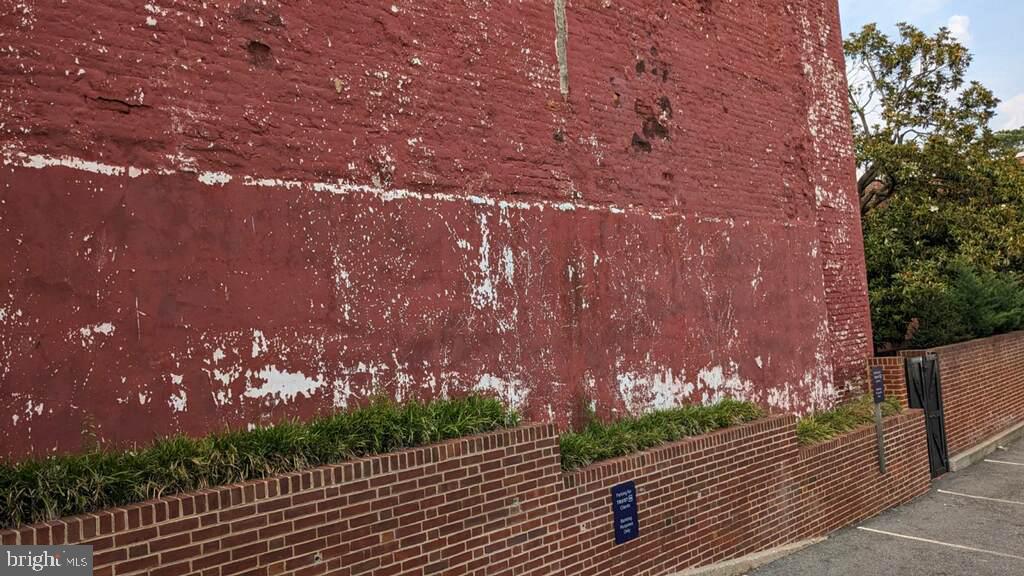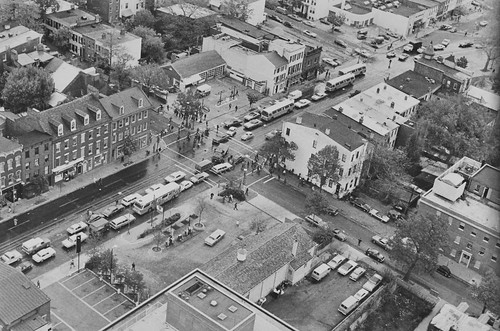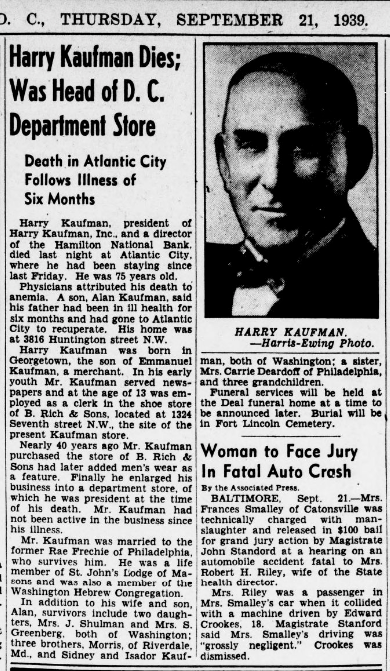
Back in 2015, Georgetown was witness to one of the more ham-fisted attempts at extortion. An individual purchased at auction a group of tax lots on an alleyway between Potomac St. and 33rd. He then proceeded to seek approval to erect fences blocking homeowners from using the alleyway. It was a fairly naked attempt to get the homeowners to pay-up. It failed, largely due to the intervention of the DC Attorney General’s office.
I bring this story up because a similar story appears to be playing out on the other side of Georgetown.
First let me relate the public story you may have heard over the weekend:
An historic wall has just been listed for sale for $50,000. The wall occupies a tiny sliver of a lot between the Truist Bank at 30th and M and the rowhouse at 1213 30th St. According to an article in DC Urban Turf the wall has a whimsical backstory:
In the early 1970s, Allan Berger’s father got wind of a tax lien auction in Georgetown. During a break from his job in the federal government, he wandered over to see what was on the block.
“He wanted to be able to say he owned property in Georgetown,” Berger told UrbanTurf.
Berger’s father came away from the auction as the proud new owner of an interesting piece of property: a red wall near the corner of 30th and M Street NW (map). Now, his son has put the wall up for sale.
In short, this story is bullshit.
Berger’s father did not obtain this lot in a tax lot auction in the 1970s. He acquired it in 1992 from a woman who was in the business of acquiring these sort of lots. As I explain more below, she bought the lots in the 60s in a tax auction and the transfer to Berger’s father has some suspicious elements.
(ed: To DC Urban Turf’s credit, they corrected their article after these facts were pointed out to them)
But before I get to that, let me talk about the wall itself.
The DC Urban Turf article does not discuss the wall’s provenance, but I am fairly confident that it is actually a remnant of the historic Union Hotel, which once stood at 30th and M.

This hotel was originally built in 1796 and later served as a military hospital during the Civil War. Louisa May Alcott served as a nurse there. As NPS wrote:
[Alcott] wrote a book about her experiences at the Union Hospital called “Hospital Sketches”. In it she describes the scene on the streets outside:
“Long trains of army wagons kept up a perpetual rumble from morning until night. Ambulances rattled to and fro with busy surgeons, nurses taking an airing or convalescents going in parties to be fitted for artificial limbs. Strings of sorry looking horses passed, saying as plainly as dumb creatures could, ‘why in a city full of them is there no horsepital for us?’ Often a cart came by, with several rough coffins in it and no mourners following; barouches, with invalid officers, rolled round the corner and carriage loads of pretty children, with black coachmen, footmen and maids.”
Life in the hospital was a tremendous strain on Miss Alcott and she succumbed to typhoid fever. Six weeks after it began, her nursing career came to a close when her father came to Washington and took her home.
It returned to service as a hotel after the war, but was later converted to flats, as you can see from this 1888 map:

You can also see in this map how the building abutted 1213 30th St. (That row of homes was built in the 1870s-80s. You can see a walled up window in the wall from when the hotel had an empty lot to the north). The former hotel was torn down in the 1930s and replaced with a gas station, as you can see in this photo from 1971:

While the former hotel was gone, the wall remained because the structural beams of the home next door were attached to it. The gas station was itself later torn down for a bank. According to DC Urban Turf, previous owners of the bank agreed to maintain the wall despite not actually owning it.
From the records, I believe the back story of the wall is this: A Georgetown-native and successful merchant, Harry Kaufman, bought up much of the block in the 1930s, including the former hotel, the wall itself, and 1213 30th St. It was Kaufman who had the former hotel razed for a gas station.

Over the subsequent years he and his heirs sold off the lots. In 1953 it appears they sold off the bulk of the lot of the former hotel but carved out a new lot for just the wall itself. It’s unclear why they did that, but I suspect it had to do with their desire to tear the former hotel building down. Maybe in order to keep the one wall standing it needed its own lot. In either event, by the 1960s the heirs had stopped paying taxes for the tiny wall lot and it was put up for a tax auction by the city. As I mentioned above, the lot was not bought by Allan Berger’s father as a lark in the 1970s. It was actually bought by an Esther Levin Sturner in an auction in 1965:

Sturner acquired a lot of these sorts of lots: i.e. tiny lots that cannot for various reasons have a building erected on it. Often, as we saw with the alley, people who buy these sorts of lots use unseemly pressure tactics–like erecting pointless fences that restrict others’ use of their own property–to get adjoining homeowners to buy the lots off their hands for a tidy profit.
If that was Stuner’s business, the elder Berger joined her in it as early as 1992.
That year Sturner transferred the wall lot, along with a bunch of other similar lots, to Martin Berger, Allan Berger’s father. In exchange, he promised to pay her $25,000 and a 75% cut of whatever he got trying to sell the lots:

That story is nothing like a federal worker buying a small piece of Georgetown on a lark.
And the wall lot is creating an untenable situation for the adjoining neighbor. As the ANC stated in a resolution last December:
ANC 2E urges the Department of Buildings (DOB) to proactively take responsibility for the
well-documented safety issues at Lot 817, Square 1210 (referred to hereafter as the
abandoned wall). Attachment 1 includes visuals of the abandoned wall.
A structural engineer from a well-regarded insurance company found that the abandoned wall
poses both a physical and personal property risk. Specifically, this expert issued a report
noting the “imminent collapse” of the abandoned wall. Lives and property damage are at risk.
● On its north side, the abandoned wall is attached to a separately owned home at 1213
30th Street NW. The abandoned wall dates back to the early 1800s and holds
structural beams for both 1213 30th Street NW as well as beams for 1215 30th Street
NW.
● On its south side, the abandoned wall sits over a parking lot that is owned by a bank
at 2929 M Street NW.
A family trust with multiple assets owns the abandoned wall. ANC 2E06 Commissioner
Gwendolyn Lohse and the homeowners of 1213 30th Street NW have worked with DOB,
under the former Department of Consumer and Regulatory Affairs (DCRA), to have notices
of infraction issued for the abandoned wall. The owner of the abandoned wall has ignored
these notices and the associated fines; meanwhile, the risk to life and property grows.
DOB appears to be unable to determine how to apply its codes to the abandoned wall given
that the wall is neither a vacant nor an abandoned building. The odd nature of this property
appears to be the cause of ongoing inaction by DOB. ANC 2E appreciates the work of DOB
staff members to assist, however the ANC calls upon DOB leadership to:
● Immediately, within the next month, have the abandoned wall secured using the
technical methods recommended by the structural engineer from the well-regarded
insurance agency USSA. The cost of the work by DOB contractors should be charged
to the owner of the abandoned wall.
● Require the owner of the abandoned wall to pay the already-issued DOB fines.
● Given the structural beams encased in the abandoned wall, consider mediating a
potential change of ownership of the abandoned wall once the current liability of
collapse has been addressed.
The property owners whose safety and property are at risk due to the abandoned wall should
not need to pursue a costly civil lawsuit against the owner of the abandoned wall. Rather,
ANC 2E and its residents look to DOB to proactively pursue a structurally sound solution.
As I mentioned above, owners of these sorts of lots often try to extort a payment from the adjoining homeowner by doing things such as erecting pointless fences and then “offering” the lot for sale. Or they may just let their property degrade to the point the neighbors have to pay them to go away. It sure looks like something of that nature is happening here.













Pingback: FS: Wall, Dreams – greg.org
Pingback: That $50K Wall for Sale in Georgetown? Neighbors Say It’s Nearing Collapse - Dmvallday
Pingback: That $50K Wall for Sale in Georgetown? Neighbors Say It’s Nearing Collapse. - Washington, D.C. News
Pingback: That $50K Wall for Sale in Georgetown? Neighbors Say It’s Nearing Collapse. – UK Poperty Guides
Pingback: A fixer-upper in Georgetown is on sale for $50,000. It’s a wall. - Coldfax Business News and Analysis
Pingback: A fixer-larger in Georgetown is on sale for $50k. It’s a wall – TOP HACKER™
I feel bad for Ms Walls the owner of the townhouse. But this seems like it should have come up in the basic due dilligence she (and her title attorney) performed when she purchased the townhome. Seems like if anyone should be on the hook for correcting this, it would be that title lawyer and their malpractice insurance. Unless, she was notified of this title defect at the time and said to hell with it. Well then, caveat emptor. . . . .
Pingback: Um consertador em Georgetown está à venda por $ 50.000. É uma parede. - Washington Sheet
Pingback: The world’s strangest and pettiest property disputes | loveproperty.com – lovePROPERTY – 986 Conley Rd Oil Springs KY
It did come up at closing. Berger said that he hadn’t thought about the wall in years and would happily fix any issues like a good neighbor and to proceed. (after all, all houses are connected). The wall can be repaired with a parging of stucco and taking out the rotted wood members that let water in the house. I figured that he would keep his word. After closing he did a 180 and let me know, “No, I will never do anything with that wall but you can buy it.” Then the price was inflated beyond what made sense to anybody involved.
Since the house was bought with full knowledge of the wall by both the purchaser and the buyer’s mortgage company (assume a mortgage was used) I find it odd that the mtg wouldn’t want to step in to resolve this asap as it effects their asset. What am I missing? Was the house bought without a mortgage?